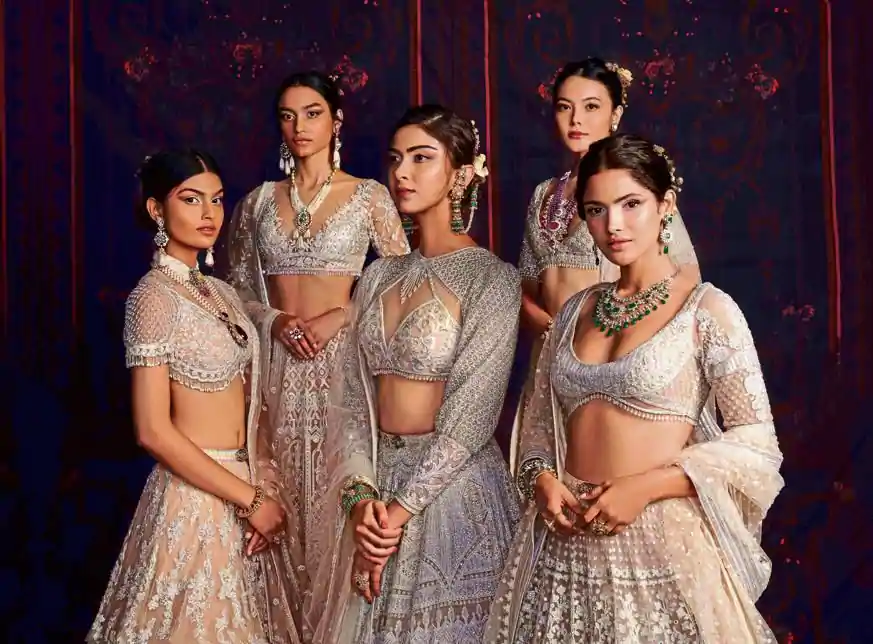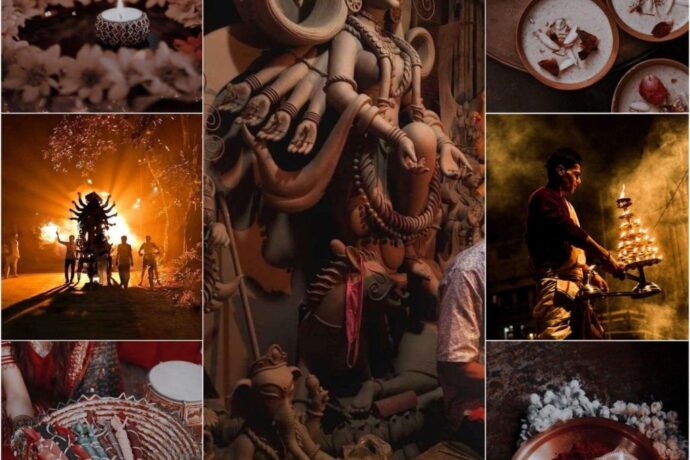She confesses she’s nervous, “or possibly I’m simply thrilled”, or “maybe anxious”. The purpose for the curler-coaster of feelings is that her debut comes at a singular time in historical past. The pandemic has hit the $2.5-trillion international fashion business so arduous that luxurious gross sales are set to contract as much as 45% this yr, with business progress unlikely to return to pre-pandemic ranges till at the least 2024, estimates a Boston Consulting Group report. At the identical time, nonetheless, it has additionally given fashion weeks a chance to look past presenting for a room stuffed with 500-odd folks and notice the complete potential of digital know-how in a submit-covid world. The pivot might additionally assist the business scale back its carbon footprint by decreasing the variety of jet-setting guests and disposable, bigger-than-life stage units.
View Full Image
Falguni and Shane Peacock’s bridal assortment on the current India Couture Week.
HOW GREEN CAN YOU GET?
Last month’s New York Fashion Week, the primary such main occasion within the covid-19 period, had a mixture of on-line displays of garments and a bodily occasion, with solely 30 folks in attendance. The London Fashion Week that adopted additionally stay-streamed collections, with some designers in masks organizing in-particular person appointments. Milan, too, opted for the hybrid route. The Indian fashion business, in the meantime, has caught to the digital area, at the least for now.
The lately concluded India Couture Week (ICW) was the nation’s first fashion present to go all digital, with pre-made shoots exhibiting fashions in designer wedding ceremony put on in a sanitized setting. And folks internationally are anticipated to observe the LFW showcase season-fluid collections over 5 days, beginning 21 October, all on a specifically designed digital platform. “It might be lots of people watching Between The Lines,” says Kilawat with a nervous laugh, referring to her collection, which reflects the simplicity of the daily routine in breezy shades of handwoven silk with colourful stitches in sujini and kantha. “But I am glad a virtual show would mean less pollution (than a physical show).”
That’s the tantalizing promise of digital fashion exhibits. They may not supply the attraction and glamour of A-listers packing the entrance rows however they may assist in attaining what the fashion business has lengthy been struggling for: reducing its carbon footprint.

View Full Image
An ensemble from Aarushi Kilawat’s debut assortment on the forthcoming Lakmé Fashion Week.
Each yr, when consumers, designers and celebrities transfer from continent to continent attending fashion weeks, they find yourself contributing 241,000 tonnes of carbon dioxide emissions—that’s sufficient to mild up New York’s Times Square for 58 years, in accordance with a February report by the fashion know-how agency ORDRE and Carbon Trust, a local weather change consultancy. Overall, the UN Environment Programme estimates that the fashion business is liable for 10% of annual international carbon emissions, greater than worldwide flights and maritime delivery mixed.
Besides garment manufacturing, waste technology and carbon-intensive provide chains, air journey is without doubt one of the large causes for the air pollution, factors out sustainability knowledgeable Linda Greer, who has been working to enhance the worldwide attire sector for many years. “Digital exhibits may have a a lot decrease carbon footprint than bizarre exhibits as a result of folks is not going to be flying 1000’s of miles from everywhere in the world to go to exhibits,” she says, on e mail.
While there’s no scientific examine but to estimate how sustainable the digital format is, one can’t overlook the power-guzzling invisible infrastructure behind a present, from the computer systems and laptops to the huge servers. But even then, says Greer, digital exhibits are “greener”. The use of tech tools does contribute to greenhouse gases but it is much less than emissions from air travel, she says. “Virtual shows are the best way forward for the fashion world.”
trying forward
Sunil Sethi, president of the Fashion Design Council of India, calls the decrease environmental price of digital fashion weeks “an icing on the cake”. When we spoke on 18 September, just hours before the council was to present the first digital ICW, Sethi was busy, replying to messages. “Honestly, I am very nervous about the response,” he mentioned. “We don’t need to reinvent the wheel in bodily exhibits. The units, the glamour, the events. It’s at all times the identical parts in some kind. With digital, we are nonetheless studying. But the great factor is there received’t be any units to discard. We have turn into a little bit green with out even making an attempt.”
Despite covid-19, Sethi mentioned it wasn’t the “greatest concept” to skip the annual event. “We are two months late (the ICW is usually held in July, before the wedding season). But we had to do it. The designers have to pay their mall rents, the people who work with the industry need their salaries. And the bride and groom need to see the collections to decide their wedding outfits. We have to present a show that catches people’s attention quickly.”
This is precisely what Falguni and Shane Peacock hoped to realize with the digital presentation of their bridal assortment on the ICW—stuffed with motifs impressed by the structure and heritage of their dwelling-city Jaipur. “Our movie exhibits the managed chaos behind a runway present. As it’s, consideration spans are so quick now; we needed to create greater than only a runway,” Falguni said before her collection was presented. While she missed the “craziness” of a bodily present, she’s glad the digital avatar opens up all the world to the designer. “It’s humorous the way it took a virus for us to pivot.”
The different plus of a digital present is that solely the product is the hero, says Raw Mango’s Sanjay Garg, who will current a set of handwoven textiles on the LFW that brings collectively the simplicity and luxurious of embroidery and bandhani “as a tribute to dwelling”. “In physical shows, we mostly focus on the photo of the dress a celebrity wore towards the end. A virtual show would mean the garment will be the showstopper (not the person wearing it),” says the designer. “Anyway, the bodily runway shouldn’t be the one medium to indicate garments. You need to suppose exterior the field to indicate the tradition, the story behind them. Digital can undoubtedly assist right here.”
Jaspreet Chandok, head (life-style companies), IMG Reliance Ltd, the LFW organizer, believes the digital sphere can redefine the fashion business. While Sethi predicts the way forward for fashion might be a mixture of bodily and digital occasions, Chandok believes “it may by no means return to regular”.
The LFW has created digital infrastructure that may supply the viewer a 360-degree expertise. Its web site has a digital showroom the place consumers and designers can work together with ease. One may even purchase garments off the ramp after seeing them from any angle. “It’s like a fashion present only for you, and it’s green,” says Chandok.
Kilawat is joyful her debut present will create a bigger narrative round sustainability, one thing she’s making an attempt to advocate by her handloom-centered model. Will she miss being a part of a bodily present? “The applause and the ramp stroll in the direction of the top.”
Subscribe to Mint Newsletters
* Enter a legitimate e mail
* Thank you for subscribing to our publication.









